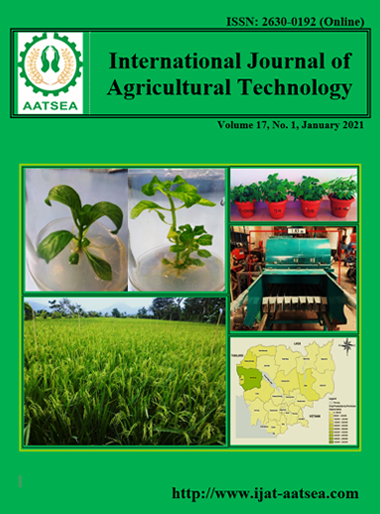Improving and effect of bio fertilizer on enhancement of the growth and bio chemical characteristic of photosynthesis on the Blackgram (Vigna mungo L.)
Main Article Content
Abstract
Biofertilizer is an increasingly available in the market as one of the option in contrast to chemical fertilizer. The effectiveness of the growth of Vigna mungo L. utilizing biofertilizers, Pseudomonas fluorescens, and Bacillus subtilis was investigated. The rhizosphere soil sample collected from Dharmapuri District. The plants were raised in pots containing soil amended with various biofertilizers application (Control, P. fluorescens, B. subtilis, P. fluorescens+ B. subtilis). The seeds of Vigna mungo L. were transplanted in 4 pots of equal size, which were noted as treatment (T1-T4). The morphological parameters such as, shoot, root and leaf length, and biochemical constituents for example chlorophyll, carotenoids, carbohydrate and protein content were analyzed at 60 days respectively. Compare with all pots the combined inoculation of the biofertilizers (T4) P. fluorescens+ B. subtilis in 60 days showed better response in all the parameters was tested
Article Details

This work is licensed under a Creative Commons Attribution-NonCommercial-NoDerivatives 4.0 International License.
References
Antoun, H. and Prevost, D. (2005). Ecology of plant growth promoting rhizobacteria. In: Siddiqui ZA editor. PGPR: biocontrol and biofertilization. Netherlands: Springer, 1-38.
Arnon, D. I. (1949). Copper enzymes in isolated chloroplasts polyphenol oxidase in Beta vulgaris. Plant physiology, 24:1-15.
Baset Mia, M. A. and Shamsuddin, Z. H. (2010). Rhizobium as a crop enhancer and biofertilizer for increased cereal production. African journal of Biotechnology, 9:6001-6009.
Hedge, J. E. and Hofreiter. (1962). Methods in carbohydrates. Chemistry Acadamic press, Newyork, 163-20.
Johri, B. N., Sharma, A. and Virdi, J. S. (2003). Rhizobacterial diversity in India and its influence on soil and plant health. Advances in Biochemical Engineering / Biotechnology, 84:49-89.
Krik, J. T. and Allen, R. L. (1965). Dependance of chloroplast pigment synthesis on protein synthetic effects of Actillione. Biochemical and Biophysical Research Communications, 27:523-275.
Lowry, O. H. and Rosebrough, N. J. (1951). Protein measurement with folin phenol reagent. Journal of Biochemistry, 193:257-265.
Maheshwari, M., Bhutani, S., Das, A., Mukherjee, R., Sharma, A., Kino, Y., Nukina, N. and Jana, N. R. (2014). Dexamethasone induces heat shock response and slows down disease progression in mouse and fly models of Huntington's disease. Human Molecular Genetics, 23:2737-2751.
Mishra, D. J., Rajvir, S., Mishra, U. K. and Kumar, S. S. (2013). Role of biofertilizer in organic agriculture: A review. Research Journal of Recent Sciences, 2:39-41.
Mortensen, E. N., Morse, B. S. and Barrett, W. A. (1992). Adaptive boundary detection using ‘live-wire’ two-dimensional dynamic programming. IEEE Proc. Computers in Cardiology, 635-638.
Rajeswar, M. and Ariff Khan, M. A. (2010). Effect of biofertilizers on crop yield and soil available nutrients of rice and maize in alfisols of Nagarjun sagar left canal command area of Andra Pradesh, India. An Asian. Journal Soil Science, 5:200-203.
Saraswathi, R., Krishnasamy, R. and Singaram, P. (2004). Nutrient management for rainfed greengram. Madras Agricultural Journal, 91:230-233.
Tamilzhiniyan, P. and Selvakumar, G. (2011).The effect of the Arbuscular Mycorrhizal fungus Glomus intraradices on the growth and yield of chilli (Capsicum annum L.) under salinity stress. World Applied Sciences Journal, 14:1209-1214.
Vessey, J. K. (2003). Plant growth promoting rhizobacteria as biofertilizer. Plant soil, 255:571586.
Wu, S. C., Cao, Z. H., Li, Z. G. and Cheung, K. C. (2005). Effect of biofertilizer containing N fixer, P and K solubilizers and AM fungi on maize growth: a greenhouse trial. Geoderma, 125:155-166.
Zarei, I., Sohrabi, Y., Heidari, G. R., Jallian, A. and Mohammadi, K. (2012). Effect of biofertilizers on grain yield and protein content of two soybean (Glycine max L.) cultivars. African Journal of Biotechnology, 11:7028-7037.


